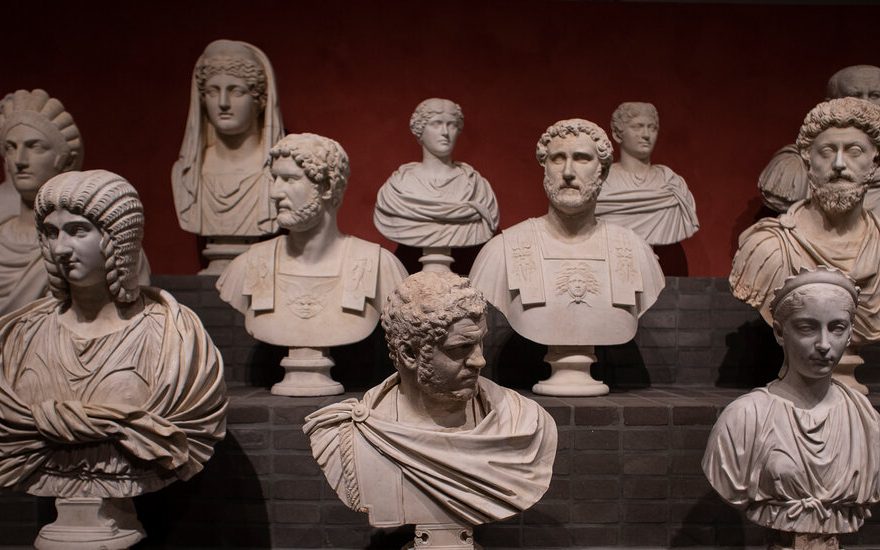ROME — For much of the last century, the Torlonia Collection, the largest collection of classical sculpture still in private hands, remained hidden to the world.
A private museum founded in 1875 to showcase the antique marbles amassed by Prince Alessandro Torlonia and his father in the tradition of noble families — like the Borghese, Barberini or Doria Pamphilj — was originally open only to a select public, and, after a few decades, not at all. Most scholars knew the 620 works — an assortment of Greek and Roman statues, busts, vases, sarcophagi and reliefs dating from the 5th century B.C. to the 4th century A.D. — only through the photographs in a catalog that was published in 1884.
Over time — including to safeguard the pieces during World War II — the collection was gradually moved into three large storerooms in Rome. As the years passed, the ancient treasures gathered layer upon layer of dust — and the mystique of the secreted collection grew.
Italian officials worked to reach an agreement with the Torlonia family to display or sell the works. But those efforts, which started in the 1960s, stalled for decades.

A breakthrough came in 2016, when the Italian government, the heirs of the Torlonia princes, and the foundation that manages the family’s artistic patrimony signed an accord to display the works. That exhibition — “The Torlonia Marbles, Collecting Masterpieces” — opened on Wednesday in a refurbished wing of the Capitoline Museums in Rome.
The show presents 92 works, which were restored for the occasion at the Torlonia Laboratory, a workshop set up on the site of the original museum in the Trastevere neighborhood. The restoration was sponsored by the luxury brand Bulgari.
“It’s an exhibit that writes a new chapter in the prestigious history of the collection,” Alessandro Poma Murialdo, the president of the Torlonia Foundation, said during a virtual news conference on Monday.
The Foundation was set up in 2013 by Prince Alessandro Torlonia, Mr. Poma Murialdo’s grandfather, who died in 2017. Mr. Poma Murialdo said in an interview that his grandfather would have been “very happy” to see the marbles at the Capitoline Museum. “He was very attached to the sculptures and had always wanted to resolve the question,” he said.
The deal with the Italian government stipulates that the collection will tour abroad after its Roman sojourn ends in June 2021. But discussions with institutions in Europe and the United States have been put on hold because of the coronavirus pandemic, said Carlotta Loverini Chigi, the managing director of the Torlonia Foundation. “We have to see how the situation evolves in order to start discussions again,” she said.
“The international tour was for us an essential part of the accord from the start,” Mr. Poma Murialdo said, adding that in the 21st century it made little sense to confine the collection to Rome or Italy. “It’s important that the collection be shared internationally,” he said.
The show at the Capitoline opens with a head-spinning panoply of busts, as well as the collection’s only bronze — a first century A.D. statue of the Roman general Germanicus — set against a backdrop of Pompeian red, echoing the walls of the original museum.
It unfolds to recount the history of the collection, described as “a collection of collections,” assembled by Prince Giovanni Torlonia and his son Alessandro “for themselves, and for the glory of the family, said the archaeologist Salvatore Settis, one of the curators of the exhibition.
The collection includes works discovered during the 19th-century excavation activities in the many properties the Torlonia owned in and around Rome, along with pieces bought on the antiquarian market, both singularly and in bulk.
The collection swelled with three key acquisitions: a collection belonging to the most important sculpture restorer of late 18th century Rome; the works amassed by a 17th-century banker considered to be among the most refined art patrons of his time; and the 18th century Villa Albani, with a vast collection curated by the German art historian Johann Joachim Winckelmann, who lived on the grounds.
These purchases introduced notable pieces, including a famous late first-century statue of a goat, whose modern head is attributed to the Baroque artist Gian Lorenzo Bernini, and a first-century-B.C. vase depicting the Labors of Hercules.
The collection also has much to reveal about how taste and restoration practices have changed over the past five centuries, said Carlo Gasparri, an archaeologist who has been working on the collection since 1976 and curated the exhibit with Mr. Settis.
The show ends with a statue of Hercules, stripped clean of its patinas to reveal what Mr. Gasparri described as “a puzzle” composed of “125 different pieces belonging to at least two different ancient statues” that were brought together in different eras. It had been coated and finished give the idea of a unitary sculpture, a typical process in the past.
“It’s not an ancient statue; it’s a modern creation of its time,” Mr. Gasparri said.
“We put this at the end to help people understand the problems” that archaeologists and restorers face, he added. “If you don’t clean a sculpture, it’s very difficult to know what you’re looking at,” he said.
The Torlonia Laboratory workshop has its work cut out for it, as restorers continue their work to bring to light all the remaining 528 works. And that was certain to offer scholars and restorers a wealth of information, he said.
“There’s much still to be discovered,” Mr. Gasparri said. “This is just a small taste.”
Source: Read Full Article
